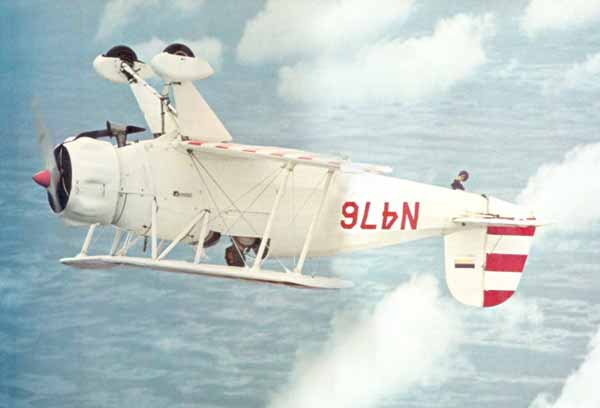
 |
Bucker Jungmiester:
160 hpSiemens |
A
Neophyte Gets his Crack at an Aerobatic Legend |
First look at the date on this
one: January 1970. Over 40 years ago! But I can see this airplane
and my first flight in it as if it were yesterday. It was fun re-reading
this from the other end of history’s
telescope. When I wrote this, I had been teaching aerobatics in a
Citabria for a little over two years, had never flown a Pitts and
aerobatics on this side of the pond was all biplanes, with an occasional
Chipmunk tossed in. We had yet to see Leo and his Stephens-soon-to-be-Laser,
and, although the Russians were cleaning our clocks with Zlins we
doggedly stuck to the Pitts. We had our vindication when, two years
later, our team, flying nothing but Pitts took every gold trophy
at the world contest. That would be the swan song of the biplane
in world competition. But, long before that, the stately old Jungmiester
was out of the competition. It was still revered, but had no chance
of being a threat because the combination of drag and gravity left
it with no vertical performance at all. Still, it was, and still
is, an incredibly delightful airplane to fly and right at the very
top of my “favorites” list, along with the Pitts and
the Bearcat. So, read on and ride along as a beginner discovers a
legend. Incidentally, this had to be in the first fifteen or twenty
articles I penned over 4,000 articles ago! Time really does fly,
when you're having fun.
I had never actually touched one of the famous German acrobatic ships—new or old—so I asked Thomas if I might sit in it. He agreed. I sat there, trying to look cool and professional, while we talked for a few minutes. Then he dropped the bombshell: "You want to fly it?" I had to ask hint to repeat what he'd said because I could hardly believe it. Want to fly a Jungmeister? What a question! At first, I objected because I wasn't sure I was a hot enough pilot to handle the machine. He asked me if I had any Citabria time, I admitted to more than my share of back-seat CFI time, and he patted me on my shoulder and sent me on my way. Trusting soul. This madness of building new antiques can be traced back to the late Jack Canary, a not-so-mad pilot/promoter who was responsible for many beautifully exotic aviation ventures. Canary was helping build the Japanese air force for 20th Century's Tora, Tora, Tora, and was killed ferrying a BT-15 to be modified for this movie. The businessmen and craftsmen he had gathered to produce the Jungmeister continued the project, and I was fortunate enough to fly Jack Canary's legacy to aviation. The only thing new about N4767 is the age of its materials. Carl Bucker is personally acting as consultant to their second-edition printing of his swept-wing aerobat, and the original blueprints are being followed to the letter. By following the original plans, there is no problem with European certification because it is produced under its original type certificate. Unfortunately, all Jungmeisters imported to the United States must have experimental stenciled across their behinds. The original type certificate for the Siemens-Halske engine was destroyed during World War II and the FAA won't certify it without seeing the original TC. Makes you wonder, doesn't it? (Editor’s Note: nothing has changed in 40 years, has it?) By doing no modernizing, the airplane plant of J. Bitz and W. Hirth inWest Germany has produced an unbelievably archaic airplane. Everything about it says 1930 biplane. which is only natural. The construction is typical for the era, with lots of wire in evidence. The N-struts, for instance, aren't N-struts. They have no connecting strut between the verticals, and are held parallel by diagonal streamlined wires—strong, but dirty. Also, the ailerons are interconnected with double streamlined wires, rather than slave struts. Bucker figured that as long as he was building an acrobatic airplane, he might as well go whole hog, and he swept both wings, rather than just the top one. This double sweep moves the center section ahead of the pilot for better visibility and easy boarding, but more important, it makes the Jungmeister snap like there's no tomorrow. As the rudder is smashed down. the advancing wings pick up lift, and around you go!
The main gear is interesting and high in drag. The Vs are spring-loaded
like an old Champion's, but the shockstruts pivot on a fixed V that sticks
out into the slipstream between the wheels. It works, but it does slow
you down. The struts extend about 10 inches in flight, so the landing
attitude is more nose-high than the take-off. |